Introduction
In the ever-evolving landscape of business operations, the integration of Robotic Process Automation (RPA) has emerged as a game-changer, empowering organizations to enhance efficiency and streamline workflows.
As highlighted in Gartner’s 2024 Magic Quadrant, leading vendors such as Automation Anywhere, Microsoft, and UiPath are revolutionizing the way businesses approach automation, each offering unique solutions tailored to diverse operational needs.
This article delves into the critical features, cost considerations, and future trends that organizations must navigate to harness the full potential of RPA.
By understanding these dynamics, Directors of Operations Efficiency can make informed decisions that not only address current challenges but also position their organizations for sustained success in an increasingly automated world.
Overview of Leading RPA Vendors in Gartner’s 2024 Magic Quadrant
Gartner’s 2024 Magic Quadrant emphasizes several top RPA vendors that are making substantial progress in providing customized solutions for various business requirements. The prominent vendors consist of Automation Anywhere, Microsoft, NICE, SS&C Blue Prism, and UiPath, each providing distinctive strengths in the field of robotic process handling.
- Automation Anywhere: Esteemed for its robust cloud-native platform, Automation Anywhere features an intuitive interface combined with advanced analytics capabilities. This makes it a superb option for entities eager to enhance their operational journey, offering the flexibility required for contemporary business settings.
- Microsoft: With the integration of Power Automate within its expansive ecosystem, Microsoft delivers seamless solutions that capitalize on existing tools. This integration appeals particularly to businesses that have already invested in Microsoft technologies, streamlining operational workflows effortlessly.
- NICE: Renowned for enhancing customer engagement and operational efficiency, NICE integrates RPA with advanced analytics. This combination not only optimizes workflows but also significantly enhances service delivery, establishing it as a strategic ally for entities focused on customer satisfaction.
- SS&C Blue Prism: Recognized for its enterprise-grade operational capabilities, SS&C Blue Prism is especially preferred in regulated sectors where compliance and security are essential. Its robust framework ensures that businesses can automate processes while adhering to strict regulatory guidelines.
- UiPath: A recognized leader in the RPA field, UiPath stands out for its user-friendly interface and extensive community support. This accessibility makes it a favored option for entities aiming to expand their initiatives swiftly and efficiently. UiPath has also developed specialized large language models (LLMs) for intelligent document processing, enhancing the accuracy, speed, and scalability of document tasks through its offerings like UiPath DocPath and CommPath.
Chris Janiszewski, Director of Analyst Relations, highlights that “RPA continues to stand out for its efficiency, accuracy, and ease of use with legacy systems,” emphasizing the importance that these tools provide to entities.
Additionally, Nintex, focusing on process intelligence and automation, serves over 8,000 organizations globally, further enriching the RPA landscape with its unique offerings.
These RPA vendors embody the diverse methodologies and approaches available in the RPA landscape, catering to varying organizational needs and operational contexts. For the Director of Operations Efficiency, understanding these distinctions is crucial in selecting an RPA solution that aligns with specific business objectives and enhances overall operational efficacy. In a recent case study, a mid-sized company encountered difficulties like manual data entry mistakes and slow software testing, which were resolved through the introduction of GUI processes.
By automating these processes, the company achieved a 70% reduction in data entry errors, accelerated testing processes by 50%, and improved overall workflow efficiency by 80%, realizing a return on investment within six months. This case exemplifies the tangible benefits RPA can deliver, making it a compelling choice for entities aiming to enhance operational efficiency.
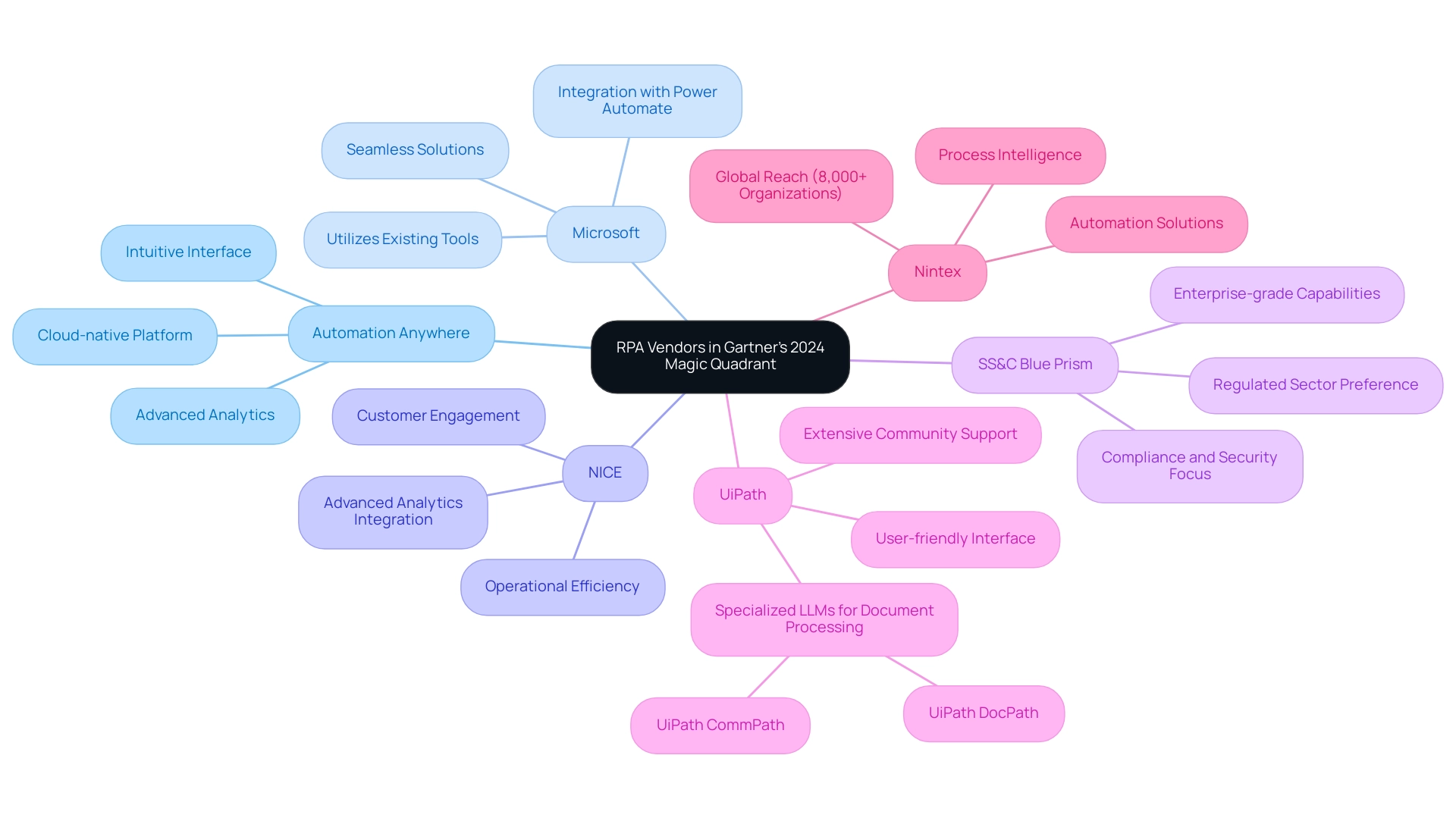
The Role of AI in Shaping the Future of RPA
The role of Artificial Intelligence in the evolution of Robotic Process Automation (RPA) is becoming increasingly essential. Through the incorporation of AI, entities can unlock advanced mechanization capabilities, including cognitive mechanization and intelligent decision-making, which are crucial for next-level operational efficiency.
-
Enhanced Decision-Making: AI algorithms empower RPA bots to analyze extensive datasets and make informed decisions in real-time, significantly enhancing the efficiency of automated processes. This capability enables organizations to react promptly to operational needs, with 83% of employees utilizing AI-driven processes reporting reduced burnout and improved job satisfaction, highlighting the positive effect of AI on workplace dynamics.
-
Natural Language Processing (NLP): The incorporation of NLP into RPA systems enables improved comprehension and processing of unstructured data, particularly beneficial for automating tasks that require understanding human language, such as managing customer service inquiries.
-
Predictive Analytics: AI-driven RPA solutions leverage predictive analytics to foresee future trends, facilitating proactive automation responses. This results in improved operational agility, enabling entities to stay ahead in a dynamic market.
-
Broader Orchestration Capabilities: As entities strive to integrate RPA with various technologies, AI’s role in orchestrating complex workflows across diverse systems becomes crucial, ensuring seamless cooperation among disparate applications and maximizing productivity.
Key features of EMMA RPA include its user-friendly interface and ability to automate complex tasks, while Microsoft Power Automate offers seamless integration with other Microsoft applications, enhancing overall operational efficiency. These tools are designed to address challenges such as staffing shortages and outdated systems by streamlining processes and reducing manual workload.
David Mayer highlights the significance of AI integration, stating, “ElevenLabs’ text-to-podcast feature, Claude can now clone your writing, a tool to sync notes across devices,” emphasizing the innovative potential of AI technologies.
Moreover, the merging of AI and RPA not only enhances operational capabilities but also enables companies to innovate and adjust to changing market demands. For instance, in the healthcare sector, RPA has the potential to automate 33% of healthcare work, with the RPA market projected to grow from $1.4 billion in 2022 to $14.18 billion by 2032. For the Director of Operations Efficiency, understanding these advancements is crucial for making strategic decisions about future investments in technology.
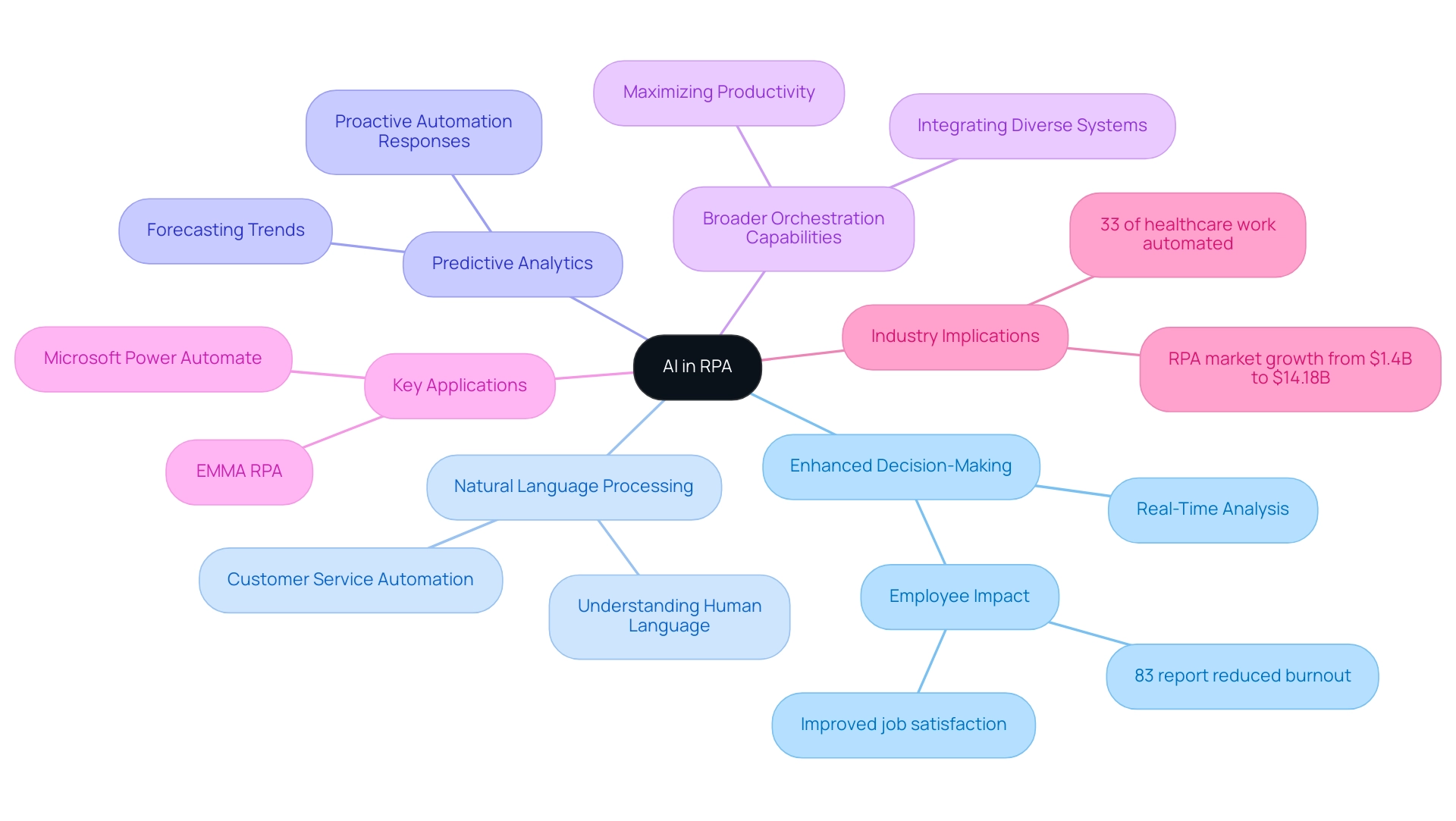
Comparative Analysis of RPA Features
When assessing RPA providers, companies must concentrate on several essential characteristics that can significantly impact their success in deploying technology:
- User Interface: An extremely user-friendly interface is crucial for ensuring that employees can swiftly embrace and efficiently use RPA tools. For example, UiPath is renowned for its user-friendly design, significantly reducing the learning curve for non-technical team members. According to Datamatics, which holds a rating of 4.5, a strong user interface can foster a culture of automation within the company, making it easier for teams to engage with these tools and combat the exhaustion caused by repetitive tasks.
- Scalability: As businesses evolve, their automation needs may shift. Vendors such as Automation Anywhere and Microsoft offer scalable RPA offerings that effortlessly accommodate increasing workloads while maintaining robust performance. This adaptability is essential for organizations looking to future-proof their operations, especially as a survey indicates that 53% of organizations have already started implementing RPA, with 78% expecting increased investment in the next three years. Addressing staffing shortages through scalable solutions can significantly enhance operational efficiency.
- Integration Capabilities: Seamless integration with existing systems is fundamental for maximizing the return on RPA investments. NICE and SS&C Blue Prism excel in this aspect, providing extensive integration options with a broad range of enterprise applications, thus ensuring that initiatives align with existing workflows and assist in modernizing outdated systems. To effectively execute these integrations, companies should evaluate their existing systems and pinpoint crucial areas for mechanization that will produce the greatest effect.
- Support Services: The quality of vendor assistance can greatly influence the success of RPA implementation. UiPath, for instance, is recognized for its vibrant community and comprehensive training resources, which help facilitate smoother onboarding processes and provide ongoing assistance for users. This support is crucial for overcoming technology implementation challenges and enhancing productivity. By acknowledging these differentiators and directly addressing the challenges of repetitive tasks and staffing shortages, organizations can strategically select RPA vendors Gartner identifies that align with their specific operational challenges and objectives. Furthermore, outlining practical steps for implementation will pave the way for successful initiatives. Ultimately, concentrating on these features aids the overarching goal of hyper-automation, establishing an intelligent automation ecosystem capable of managing cognitive and decision-oriented tasks, and utilizing customized AI approaches and Business Intelligence for informed decision-making.
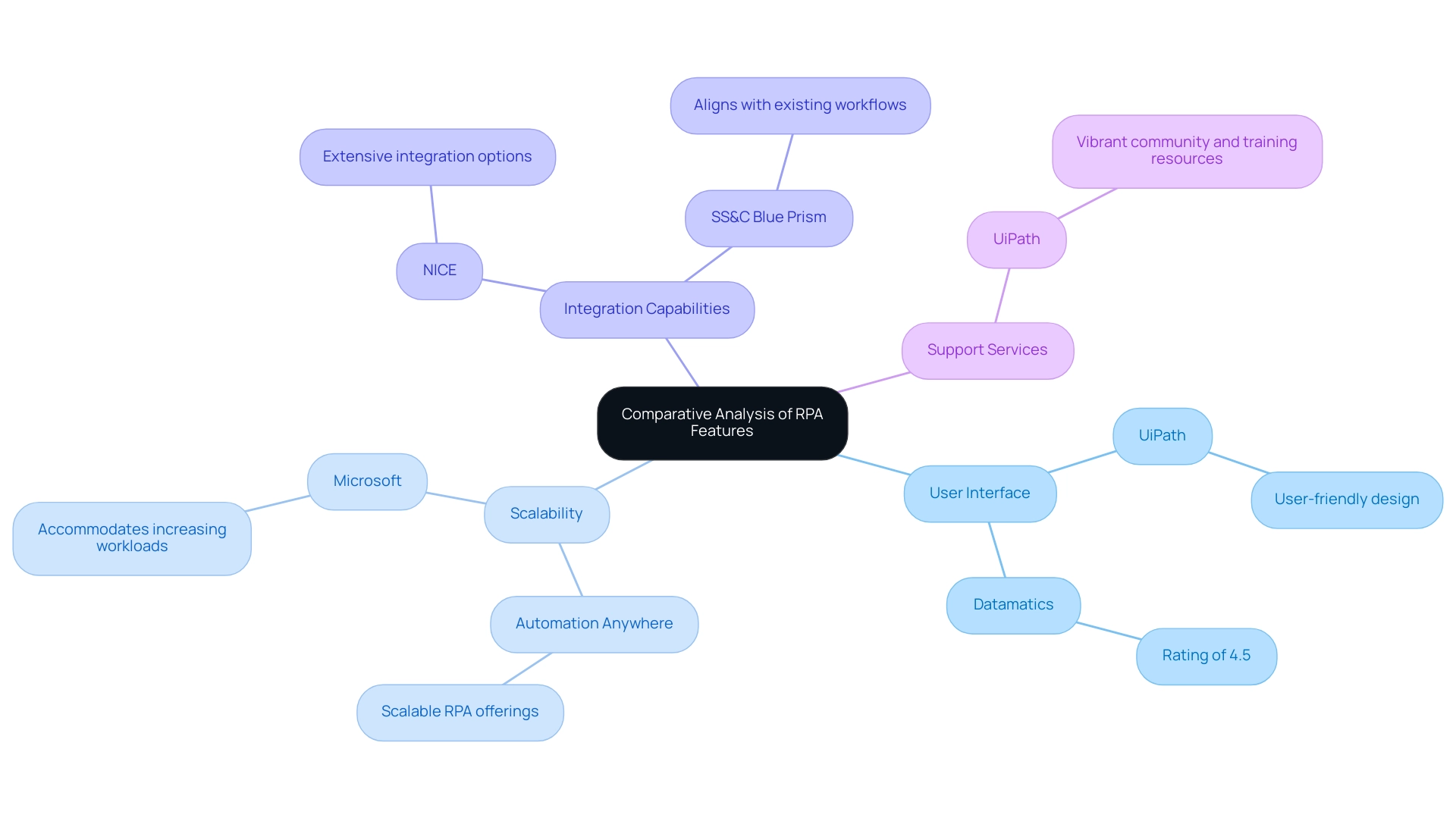
Cost Considerations for RPA Implementation
Cost plays a pivotal role in selecting RPA vendors Gartner, as pricing can vary significantly based on the features and capabilities provided. As Tajammul Pangarkar, CMO at Prudour Pvt Ltd, reflects, technology’s impact on operational efficiency is crucial, especially in today’s rapidly evolving landscape shaped by AI advancements. Key factors to consider include:
-
Licensing Fees: Vendors present various pricing models, such as subscription-based and per-bot licensing. Companies recognized as RPA vendors Gartner, such as Automation Anywhere and UiPath, typically offer flexible pricing structures, catering to organizations of all sizes. This adaptability is crucial, particularly in sectors like fintech, where the estimated cost for automating document processing ranges from $75,000 to $200,000.
-
Implementation Costs: The initial setup and integration of RPA solutions can lead to additional expenses. Organizations must consider consulting services, training, and potential infrastructure improvements to ensure a smooth shift to automated processes.
-
Maintenance and Support: Ongoing costs for maintenance and support are equally important. Vendors such as Microsoft provide comprehensive support packages, alleviating long-term expenses associated with troubleshooting and software updates, ensuring continuous operational efficiency.
-
ROI Measurement: Establishing metrics for measuring the return on investment (ROI) from RPA initiatives is vital. Organizations can establish metrics by analyzing key performance indicators (KPIs) such as time saved, error reduction, and cost savings. By contrasting the costs of manual processes with anticipated savings from automation, decision-makers can substantiate their investments effectively. Furthermore, as industry bodies work on establishing standards for RPA implementations, companies can look forward to enhanced best practices from RPA vendors Gartner, which ensure interoperability and security, ultimately influencing cost management strategies.
Additionally, the case study titled “Streamlining Operations with GUI Automation” illustrates how a mid-sized company improved efficiency by automating data entry, software testing, and legacy system integration. This example highlights the challenges faced, such as manual data entry errors and slow testing processes, and showcases the measurable outcomes: a 70% reduction in data entry errors and an 80% improvement in workflow efficiency within just six months. This transition underscores the challenges and strategies involved in adapting to new technologies, informing cost considerations for RPA implementation.
By meticulously assessing these cost considerations and learning from real-world examples, entities can make informed decisions that align with their financial objectives while maximizing the advantages of RPA, ultimately steering digital transformation in their respective industries.
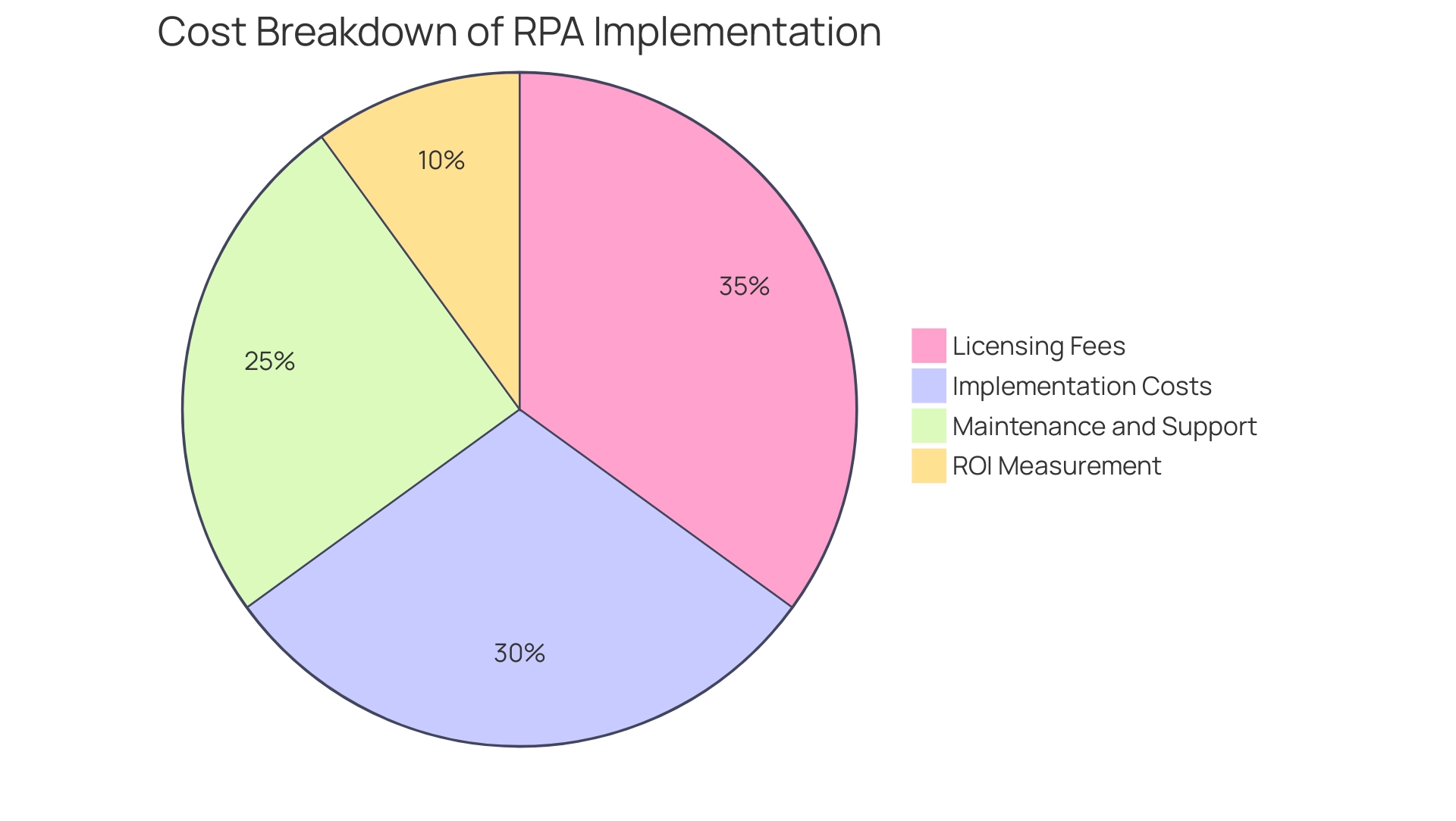
Future Trends in RPA and AI Integration
The landscape of Robotic Process Automation (RPA) is rapidly transforming, as highlighted by RPA vendors Gartner, fueled by technological advancements and the evolving needs of businesses. RPA can handle up to 90% of data entry tasks in clinical research, illustrating its practical impact on efficiency. However, companies often grapple with challenges such as poor master data quality, which can hinder effective AI implementation and lead to flawed decision-making.
Here are key future trends that leaders should prioritize to overcome these barriers:
- Increased AI Integration: The fusion of AI with RPA solutions will empower organizations to automate complex tasks and enhance decision-making processes. By addressing concerns about cost and complexity, this integration offers a pathway to improved business outcomes. On average, workers save 3.6 hours per week by utilizing technology, underscoring the quantifiable benefits of RPA and AI integration.
- Hyperautomation: This innovative approach leverages a multitude of technologies for streamlining processes, including RPA, AI, and machine learning, to formulate a holistic strategy. By addressing end-to-end business processes, hyperautomation can significantly streamline operations and improve efficiency.
- Focus on Citizen Development: The rise of low-code and no-code platforms is revolutionizing how organizations empower their workforce. By allowing non-technical staff to create their own solutions, businesses can encourage innovation and speed up implementation cycles, resulting in quick responses to market demands.
- Enhanced Security Measures: As automation becomes more prevalent, safeguarding sensitive data is paramount. Vendors are prioritizing robust security features to ensure compliance with regulations and protect organizational integrity in an automated environment.
Additionally, entities must acknowledge that AI projects can often be perceived as time-intensive, costly, and challenging to implement. Addressing these perceptions is crucial for successful adoption. Tailored AI solutions can assist entities in navigating these complexities effectively.
As Tajammul Pangarkar, CMO at Prudour Pvt Ltd, notes, “When he’s not ruminating about various happenings in the tech world, he can usually be found indulging in his next favorite interest – table tennis.” By staying informed of these trends, organizations can strategically leverage the evolving capabilities of RPA and AI, as recommended by RPA vendors Gartner, ensuring a competitive edge in their industries.
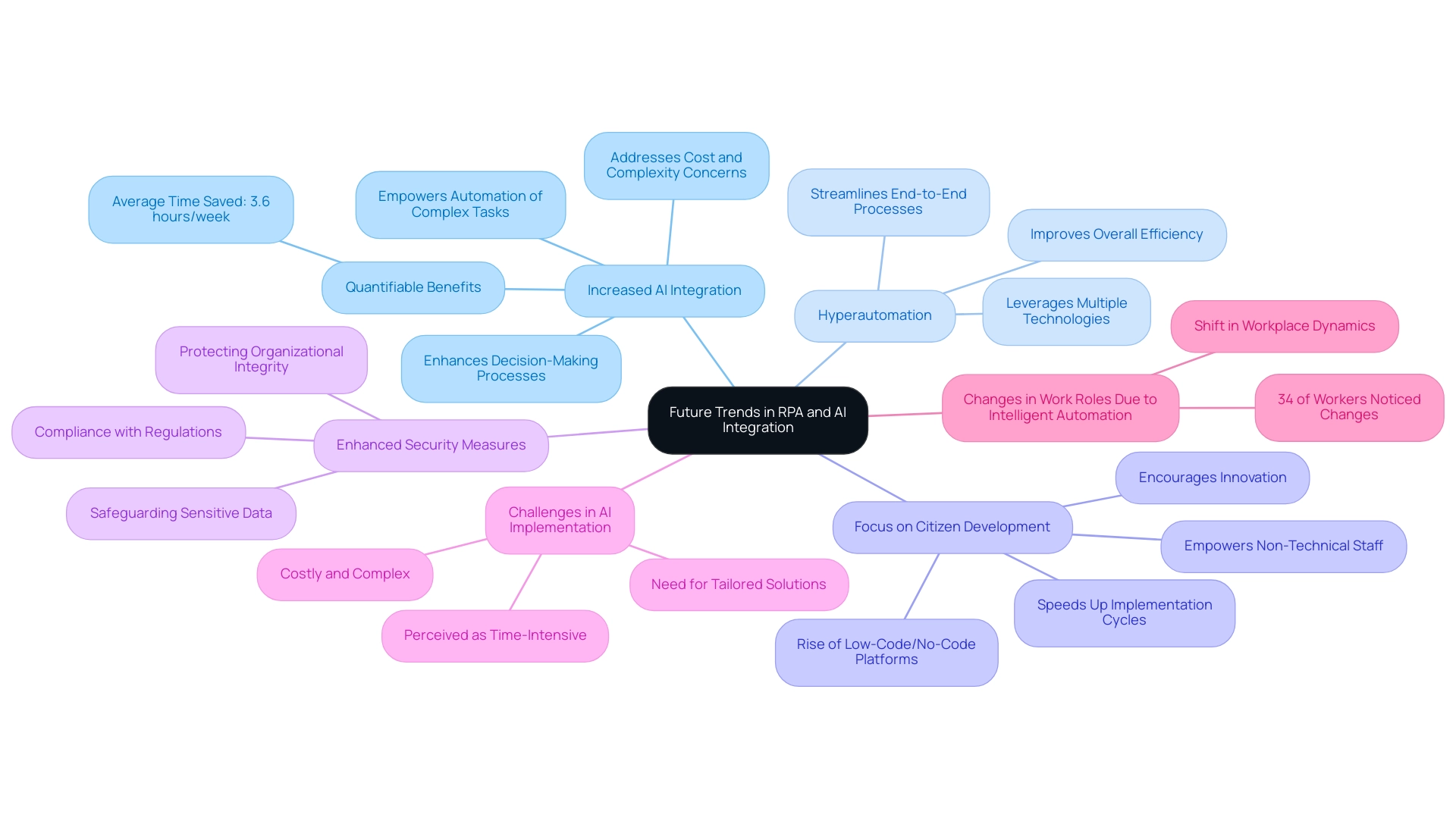
Conclusion
The integration of Robotic Process Automation (RPA) is undeniably reshaping the operational landscape for businesses seeking enhanced efficiency. By examining the leading vendors highlighted in Gartner’s 2024 Magic Quadrant, such as Automation Anywhere, Microsoft, and UiPath, organizations can identify unique solutions tailored to their specific needs. These tools not only streamline workflows but also significantly reduce errors, as evidenced by case studies showcasing remarkable improvements in operational metrics.
As AI continues to evolve, its role within RPA becomes increasingly pivotal, enabling organizations to harness advanced capabilities such as cognitive automation and predictive analytics. This synergy not only enhances decision-making but also empowers businesses to respond swiftly to changing demands, ultimately fostering a culture of innovation and agility. The emphasis on user-friendly interfaces, scalability, and robust support further underscores the importance of selecting the right RPA vendor to maximize investment and drive success.
Looking ahead, the trends of hyperautomation and citizen development will likely dominate the RPA landscape, offering organizations new avenues to streamline processes and empower their workforce. By prioritizing these advancements and addressing the associated cost considerations, Directors of Operations Efficiency can position their organizations for sustained success in an increasingly automated world. Embracing RPA is not merely a response to current challenges; it is a strategic investment in the future, paving the way for operational excellence and competitive advantage.

